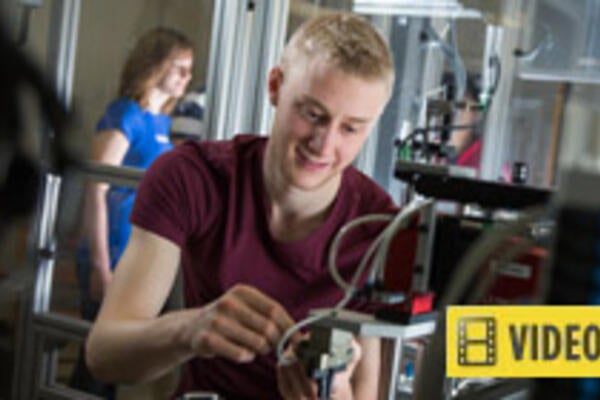
Showcasing Canadian work
Integrated Learning Research and Practice

Integrated Learning Research and Practice
By Ashley Stirling & Judene Pretti Academica GroupToday, experience is no longer the exception: it is the expectation.
Many Canadian postsecondary institutions put work-integrated learning (WIL) at the forefront of preparing students to enter the workforce. As more organizations begin to recognize the benefits of WIL, there is an increasing need to further progress our understanding and the research in the field. Doing so will help to advance empirically informed quality WIL practice in the Canadian context.
Across Canada, a growing number of academics are focusing their research on the practice of co-operative education and work-integrated learning. This body of work will become increasingly important, especially for academic institutions, as students and employers continue to prepare for the future beyond COVID-19.
We recently developed an ebook - The Practice of Co-op and Work-Integrated Learning in the Canadian Context – that highlights existing research on the subject in order to inspire researchers and practitioners to apply research and evaluation to their own WIL practice. This was a community effort and would not have been possible without the collaboration of the Co-operative Education and Work-Integrated Learning Canada (CEWIL Canada) community. That community effort resulted in a large volume of quality submissions that reflect the growing field of study on WIL and research from across a range of disciplines, provincial and territorial lines, and both college and university sectors. As the editors of this publication, we learned a lot about the landscape of WIL research and the various types of WIL taking place.
The research ranges in topics from the ascension of WIL in Canada and how WIL can be understood by applying a focus on purpose, to distinct outcomes of WIL across diverse disciplines of study. Through the review of these bodies of work, several themes emerged that could be applied to our current understanding of WIL and the importance that it can play in a post-pandemic world.
Empirical research shows that WIL has the potential to make a significant impact on students, institutions, communities, and industries alike when purposefully designed and delivered. When WIL opportunities are backed by purpose, we observe increased satisfaction in learning outcomes and experience gained and better engagement in future opportunities. This is especially true when there are clear connections to academic learning, relevant work experience, and the ability to contribute meaningfully (See: Chapters 3 – 6).
To help institutions develop better WIL experiences, in the ebook (specifically chapter 2), the authors outline a purpose and outcomes driven framework, which emphasizes the need to intentionally define the primary purpose of the WIL experience as a foundation for making decisions about a WIL program, including, definition, design, delivery and quality attributes. This framework can help educators operationalize the Work-Integrated Learning Quality Framework, AAA★, which was previously developed at the University of Waterloo and subsequently adopted by CEWIL Canada as a way focus the design and evaluation of WIL programs on existing research and evidence. It is a tool that can help establish and develop processes that lead to quality, sustainable WIL experiences. When implemented, this helps improve the experience of students, employers and educators, leading to stronger outcomes across groups. It provides students, institutions, and employers with reasons behind the work and aims to help them establish goals for WIL.
The COVID-19 pandemic caused tremendous changes in the workplace and workplace relationships. Disruptions to the way we traditionally approached work included everything from the shift to online and the growth of remote/hybrid work environments to increasing reliance on technology (see chapter 9).
In the same way that our perspectives on how we work have changed, the perspectives of how students can contribute to the workplace have continued to evolve. Students demonstrated adaptability and innovation through their WIL experiences. This resilience positions them well to support organizations as they re-design the future workplace.
WIL provides opportunities for organizations to connect with these students early. Doing so can help organizations to innovate and prepare for an unknown future.
In Canada, there is growing support from all levels of government to increase WIL at postsecondary institutions. We have seen unprecedented investment of federal funding in the Canadian WIL ecosystem, especially through the pandemic.
In the ebook (specifically chapters 6 through 8), the authors explored community-engaged learning (CEL) and the importance of faculty support for successful implementation of a WIL program with meaningful impact. Whether within communities or with students, institutions and employers, partnerships are crucial elements in providing opportunities that benefit all participants. When we approach WIL relationships from a perspective of partnership versus transactional, we see an increase in engagement and open opportunities for innovation in WIL opportunities.
Partnerships across institutions will also be critical in establishing and continuing to uphold standards in WIL. These partnerships can be buoyed by organizations like CEWIL Canada, which help connect institutions, employers, and researchers from across Canada and establish standards of practice related to WIL. CEWIL’s national database brings together more than 50 postsecondary member institutions, offering a central location for creating and sharing resources and research.
There is significant activity and excitement about WIL in Canada and a great opportunity for global leadership based on longstanding experience in this area. As the predicted trends for the future of work unfold it will be important to consider the ways in which WIL programs need to evolve to continue to support the needs of students, community and industry. A key component its successful growth will be the accompanying research to examine and understand its impacts for all stakeholders: students, employer/community organizations, educational institutions, and governments.

Read more
The world is at a historic crossroads with the largest generation of young people coming into the workforce at the same time as the fourth industrial revolution.

Read more
Case studies from work terms help engineering students solve real-world problems

Read more
Research from the Work-Learn Institute is helping employers understand the needs of their future workforce
The University of Waterloo acknowledges that much of our work takes place on the traditional territory of the Neutral, Anishinaabeg, and Haudenosaunee peoples. Our main campus is situated on the Haldimand Tract, the land granted to the Six Nations that includes six miles on each side of the Grand River. Our active work toward reconciliation takes place across our campuses through research, learning, teaching, and community building, and is co-ordinated within the Office of Indigenous Relations.